The 'New Look': Fashion Design, Marketing, and Production in 1950s
VerifiedAdded on 2023/05/31
|11
|2744
|122
Report
AI Summary
This report analyzes the emergence of the 'New Look' fashion trend by Christian Dior in the 1950s, examining its economic, cultural, and technological context. It discusses how the New Look, characterized by its full skirts and wasp waists, revitalized the French fashion industry post-war and offered a stark contrast to the utilitarian styles of the time. The report explores the economic impact, noting the high cost of original Dior gowns and the subsequent rise of mass-produced copies. It also considers cultural perceptions, highlighting differing receptions in France, Britain, and America. Furthermore, the report assesses the trend's lasting influence on contemporary fashion, including the introduction of structured outfits and the democratization of fashion, with Desklib providing access to similar solved assignments for students.

Running head: FASHION DESIGN WITH MARKETING AND PRODUCTION
Fashion Design with Marketing and Production
Student’s Name
University Name
Author’s Note
Fashion Design with Marketing and Production
Student’s Name
University Name
Author’s Note
Paraphrase This Document
Need a fresh take? Get an instant paraphrase of this document with our AI Paraphraser
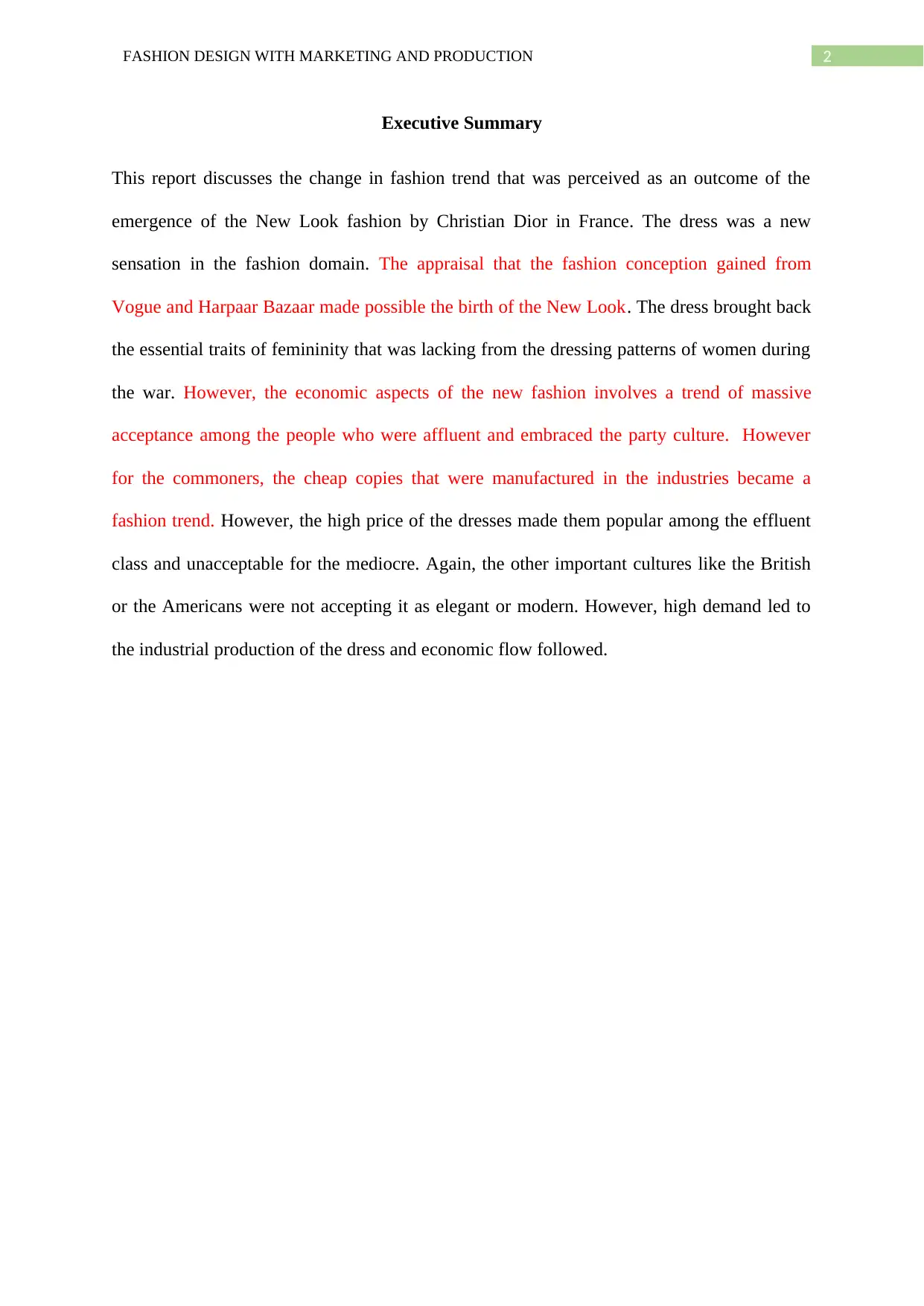
2FASHION DESIGN WITH MARKETING AND PRODUCTION
Executive Summary
This report discusses the change in fashion trend that was perceived as an outcome of the
emergence of the New Look fashion by Christian Dior in France. The dress was a new
sensation in the fashion domain. The appraisal that the fashion conception gained from
Vogue and Harpaar Bazaar made possible the birth of the New Look. The dress brought back
the essential traits of femininity that was lacking from the dressing patterns of women during
the war. However, the economic aspects of the new fashion involves a trend of massive
acceptance among the people who were affluent and embraced the party culture. However
for the commoners, the cheap copies that were manufactured in the industries became a
fashion trend. However, the high price of the dresses made them popular among the effluent
class and unacceptable for the mediocre. Again, the other important cultures like the British
or the Americans were not accepting it as elegant or modern. However, high demand led to
the industrial production of the dress and economic flow followed.
Executive Summary
This report discusses the change in fashion trend that was perceived as an outcome of the
emergence of the New Look fashion by Christian Dior in France. The dress was a new
sensation in the fashion domain. The appraisal that the fashion conception gained from
Vogue and Harpaar Bazaar made possible the birth of the New Look. The dress brought back
the essential traits of femininity that was lacking from the dressing patterns of women during
the war. However, the economic aspects of the new fashion involves a trend of massive
acceptance among the people who were affluent and embraced the party culture. However
for the commoners, the cheap copies that were manufactured in the industries became a
fashion trend. However, the high price of the dresses made them popular among the effluent
class and unacceptable for the mediocre. Again, the other important cultures like the British
or the Americans were not accepting it as elegant or modern. However, high demand led to
the industrial production of the dress and economic flow followed.

3FASHION DESIGN WITH MARKETING AND PRODUCTION
Table of Contents
1. Analysis of the emergence of a trend.....................................................................................3
1.1 Definition..........................................................................................................................3
1.2 Emergence of the trend.....................................................................................................3
1.3 Economic, Cultural & Technological context of the selected period...............................4
1.4 Development of the trend within the wider context of the fashion world........................6
2.1 Impact on the contemporary Fashion...............................................................................7
Reference List............................................................................................................................9
Table of Contents
1. Analysis of the emergence of a trend.....................................................................................3
1.1 Definition..........................................................................................................................3
1.2 Emergence of the trend.....................................................................................................3
1.3 Economic, Cultural & Technological context of the selected period...............................4
1.4 Development of the trend within the wider context of the fashion world........................6
2.1 Impact on the contemporary Fashion...............................................................................7
Reference List............................................................................................................................9
⊘ This is a preview!⊘
Do you want full access?
Subscribe today to unlock all pages.

Trusted by 1+ million students worldwide
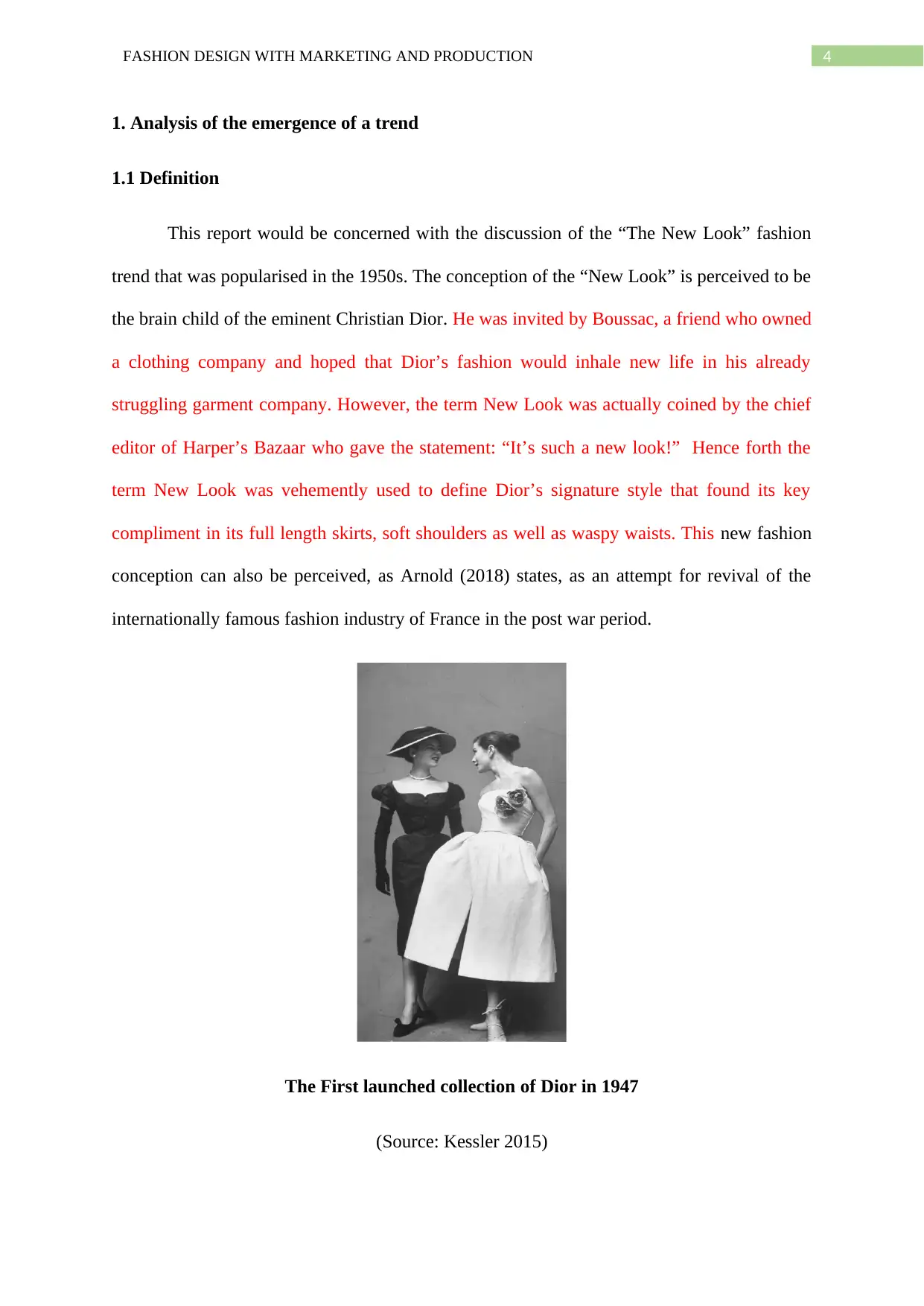
4FASHION DESIGN WITH MARKETING AND PRODUCTION
1. Analysis of the emergence of a trend
1.1 Definition
This report would be concerned with the discussion of the “The New Look” fashion
trend that was popularised in the 1950s. The conception of the “New Look” is perceived to be
the brain child of the eminent Christian Dior. He was invited by Boussac, a friend who owned
a clothing company and hoped that Dior’s fashion would inhale new life in his already
struggling garment company. However, the term New Look was actually coined by the chief
editor of Harper’s Bazaar who gave the statement: “It’s such a new look!” Hence forth the
term New Look was vehemently used to define Dior’s signature style that found its key
compliment in its full length skirts, soft shoulders as well as waspy waists. This new fashion
conception can also be perceived, as Arnold (2018) states, as an attempt for revival of the
internationally famous fashion industry of France in the post war period.
The First launched collection of Dior in 1947
(Source: Kessler 2015)
1. Analysis of the emergence of a trend
1.1 Definition
This report would be concerned with the discussion of the “The New Look” fashion
trend that was popularised in the 1950s. The conception of the “New Look” is perceived to be
the brain child of the eminent Christian Dior. He was invited by Boussac, a friend who owned
a clothing company and hoped that Dior’s fashion would inhale new life in his already
struggling garment company. However, the term New Look was actually coined by the chief
editor of Harper’s Bazaar who gave the statement: “It’s such a new look!” Hence forth the
term New Look was vehemently used to define Dior’s signature style that found its key
compliment in its full length skirts, soft shoulders as well as waspy waists. This new fashion
conception can also be perceived, as Arnold (2018) states, as an attempt for revival of the
internationally famous fashion industry of France in the post war period.
The First launched collection of Dior in 1947
(Source: Kessler 2015)
Paraphrase This Document
Need a fresh take? Get an instant paraphrase of this document with our AI Paraphraser

5FASHION DESIGN WITH MARKETING AND PRODUCTION
1.2 Emergence of the trend
In the year 1947, Christian Dior came up with the latest fashion trend that quite
rebellious in contest to the fashion sense of the European origination in the 1950s. Dior
presented a layout of one fitted jacket that has a nip at the waist line and is accompanied by a
skirt of full calf length. The rationing of cloth fabric during the span of 1947 to 1950s was a
stark reality. In contrast, Lagier and Ranfagni (2018), states that the lavish usage of fabric
material by Christian Dior have been a bold move that was a shock for the contemporary
fashion industry. According to the data provided by Izberk-Bilgin and Nakata (2016), 10
yards of cloth was already being used for the dresses pertaining to “The New Look” early
patterns of style. However, in the latter versions, almost 80 yards of cloth went in to the
dresses that were modelled as a later version of the “New Look” by Dior.
The emergence of the new fashion trend by Dior was particularly poised owing to the
time that he chose for the exhibition of his new model of dresses. The women were actually
craving for some frivolity in their fashion trends as they were already tired from the fashion
attires that according to Reis et al. (2018), were an extended version of the military outfits
that were in vogue at that times. That is why they demanded more feminine fashion. As
Parmentier (2016), informs, the Life Magazine captioned the Corolle line fashion of
accompanied by the huit by Dior as the New Look in the year 1947. Fashion critics have
come to opine that the evening suits of the New Look fashion trend were the most glamorous.
The strapless and boned tops accompanied by full skirts bore an ultra-feminine touch. In fact
Dior was highly inspired by flowers. In the launch of the new Look, Dior had exclaimed that:
“After woman, flowers are the loveliest thing God has given the world… I design clothes
for flower-like women.” The fashionable outfits designed by Dior dominated the French
1.2 Emergence of the trend
In the year 1947, Christian Dior came up with the latest fashion trend that quite
rebellious in contest to the fashion sense of the European origination in the 1950s. Dior
presented a layout of one fitted jacket that has a nip at the waist line and is accompanied by a
skirt of full calf length. The rationing of cloth fabric during the span of 1947 to 1950s was a
stark reality. In contrast, Lagier and Ranfagni (2018), states that the lavish usage of fabric
material by Christian Dior have been a bold move that was a shock for the contemporary
fashion industry. According to the data provided by Izberk-Bilgin and Nakata (2016), 10
yards of cloth was already being used for the dresses pertaining to “The New Look” early
patterns of style. However, in the latter versions, almost 80 yards of cloth went in to the
dresses that were modelled as a later version of the “New Look” by Dior.
The emergence of the new fashion trend by Dior was particularly poised owing to the
time that he chose for the exhibition of his new model of dresses. The women were actually
craving for some frivolity in their fashion trends as they were already tired from the fashion
attires that according to Reis et al. (2018), were an extended version of the military outfits
that were in vogue at that times. That is why they demanded more feminine fashion. As
Parmentier (2016), informs, the Life Magazine captioned the Corolle line fashion of
accompanied by the huit by Dior as the New Look in the year 1947. Fashion critics have
come to opine that the evening suits of the New Look fashion trend were the most glamorous.
The strapless and boned tops accompanied by full skirts bore an ultra-feminine touch. In fact
Dior was highly inspired by flowers. In the launch of the new Look, Dior had exclaimed that:
“After woman, flowers are the loveliest thing God has given the world… I design clothes
for flower-like women.” The fashionable outfits designed by Dior dominated the French

6FASHION DESIGN WITH MARKETING AND PRODUCTION
Fashion Domain for 10 years. Pitted against the stuffy normality of the 40s era, the change
that was brought about by Dior paved the way for more new outfit designs in the latter years
like 1956.
1.3 Economic, Cultural & Technological context of the selected period
It is evident that all women of the 1950s could not afford a new Dior Ball for every
formal occasion. However the prices of the New Look gowns were comparatively cheaper
than the outstation sources where the products were available. Dior’s gowns were ranged
from $3000 to $400. Hence it was evident that for practical day to day use, the products were
not adaptable. Rather they found that in the blooming days of the New Look fashion, there
were no suitable alternatives to the trendy baggy and heavy weight dresses that had the least
bit of femininity. That is why, Jones (2015), have stated that for occasions like formal
evenings and other famous parties, the dresses of The “New Look” were most suitable.
However, Zanette and Scaraboto (2018), states that the handmade couture had played a great
role in accomplishing the wartime distorted fortune of the French economy.
The original fashion garments of Christian Dior were above the budget of the
common people. However since this was a very widespread and revolutionary fashion, people
of every strata of life were eager to incorporate this fashion statement. This is because most
of the people were fed up with the baggy war time jackets and short hair that was the only
fashion trend of the day. The Golden age of Culture that started with this new fashion
sensation was used for the benefits of the corporate houses. Gardetti and Girón (2017), sates
that no sooner than the industrial entrepreneurs started to realise the huge demand of the cloth
range, they production of industrial copies of the products at a high scale started to flourish.
Made of cheap linen these industrially manufactured garments were immensely
popular among the average working class European ladies. However, Stokes (2015) describes
Fashion Domain for 10 years. Pitted against the stuffy normality of the 40s era, the change
that was brought about by Dior paved the way for more new outfit designs in the latter years
like 1956.
1.3 Economic, Cultural & Technological context of the selected period
It is evident that all women of the 1950s could not afford a new Dior Ball for every
formal occasion. However the prices of the New Look gowns were comparatively cheaper
than the outstation sources where the products were available. Dior’s gowns were ranged
from $3000 to $400. Hence it was evident that for practical day to day use, the products were
not adaptable. Rather they found that in the blooming days of the New Look fashion, there
were no suitable alternatives to the trendy baggy and heavy weight dresses that had the least
bit of femininity. That is why, Jones (2015), have stated that for occasions like formal
evenings and other famous parties, the dresses of The “New Look” were most suitable.
However, Zanette and Scaraboto (2018), states that the handmade couture had played a great
role in accomplishing the wartime distorted fortune of the French economy.
The original fashion garments of Christian Dior were above the budget of the
common people. However since this was a very widespread and revolutionary fashion, people
of every strata of life were eager to incorporate this fashion statement. This is because most
of the people were fed up with the baggy war time jackets and short hair that was the only
fashion trend of the day. The Golden age of Culture that started with this new fashion
sensation was used for the benefits of the corporate houses. Gardetti and Girón (2017), sates
that no sooner than the industrial entrepreneurs started to realise the huge demand of the cloth
range, they production of industrial copies of the products at a high scale started to flourish.
Made of cheap linen these industrially manufactured garments were immensely
popular among the average working class European ladies. However, Stokes (2015) describes
⊘ This is a preview!⊘
Do you want full access?
Subscribe today to unlock all pages.

Trusted by 1+ million students worldwide

7FASHION DESIGN WITH MARKETING AND PRODUCTION
that in France the cheap substitute of the dresses that were made in the factories were never
popular. The French women did not accept the industrially produced New Look dresses. On
the contrary, Donzé and Fujioka (2015), denotes that in the foreign countries, these dresses
that were industrially produced in the European factories with cheap linen were immensely
popular in the external regions and in the foreign countries like America. In USA, people
recognised this fashion from the industrially produced dresses that were exported to those
regions. They did not have a very good conception of the authentic and original handmade
dresses that bore the emblem of the Dior fashion. The Dior fashion was also influenced by
the current musical trends that were emerging at that time. The Rock and R&B culture
enticed the Europeans and Americans to join music nights and other outhouse parties. As an
outcome, the new fashion culture of Dior gained a sensational acceptance among the people.
This craze fostered by the industrial production of the garments pertaining to the new look. In
the latter part of the 1960s, designers like Jean Ozenne were inspired by Dior’s fashion and
working for couture houses, introduced the Corolle and huit fashion to the entire world.
The fashion culture had democratised fashion. The implications of war had
democratised fashion and edged the fashion gap between the rich and poor. Dresses like
snood that were in vogue had prevented the women from unleashing their feminine spirit.
The spirit of consumerism was absent from the apparel business of the dy. As an outcome,
this was considered as a time of dyeing the legs brown and as well as painting the seam down
the backs of calves in the dress in order to simulate the stockings. Pitted against this
background, the New Look fashion of Christian Dior marked the beginning of the age that
made an attempt to return to normality, abrupt and sudden reappearance of the traits of
femininity in fashion as well as a subtle exhibition of extravagance that was accepted as an
emblem of feminism.
that in France the cheap substitute of the dresses that were made in the factories were never
popular. The French women did not accept the industrially produced New Look dresses. On
the contrary, Donzé and Fujioka (2015), denotes that in the foreign countries, these dresses
that were industrially produced in the European factories with cheap linen were immensely
popular in the external regions and in the foreign countries like America. In USA, people
recognised this fashion from the industrially produced dresses that were exported to those
regions. They did not have a very good conception of the authentic and original handmade
dresses that bore the emblem of the Dior fashion. The Dior fashion was also influenced by
the current musical trends that were emerging at that time. The Rock and R&B culture
enticed the Europeans and Americans to join music nights and other outhouse parties. As an
outcome, the new fashion culture of Dior gained a sensational acceptance among the people.
This craze fostered by the industrial production of the garments pertaining to the new look. In
the latter part of the 1960s, designers like Jean Ozenne were inspired by Dior’s fashion and
working for couture houses, introduced the Corolle and huit fashion to the entire world.
The fashion culture had democratised fashion. The implications of war had
democratised fashion and edged the fashion gap between the rich and poor. Dresses like
snood that were in vogue had prevented the women from unleashing their feminine spirit.
The spirit of consumerism was absent from the apparel business of the dy. As an outcome,
this was considered as a time of dyeing the legs brown and as well as painting the seam down
the backs of calves in the dress in order to simulate the stockings. Pitted against this
background, the New Look fashion of Christian Dior marked the beginning of the age that
made an attempt to return to normality, abrupt and sudden reappearance of the traits of
femininity in fashion as well as a subtle exhibition of extravagance that was accepted as an
emblem of feminism.
Paraphrase This Document
Need a fresh take? Get an instant paraphrase of this document with our AI Paraphraser
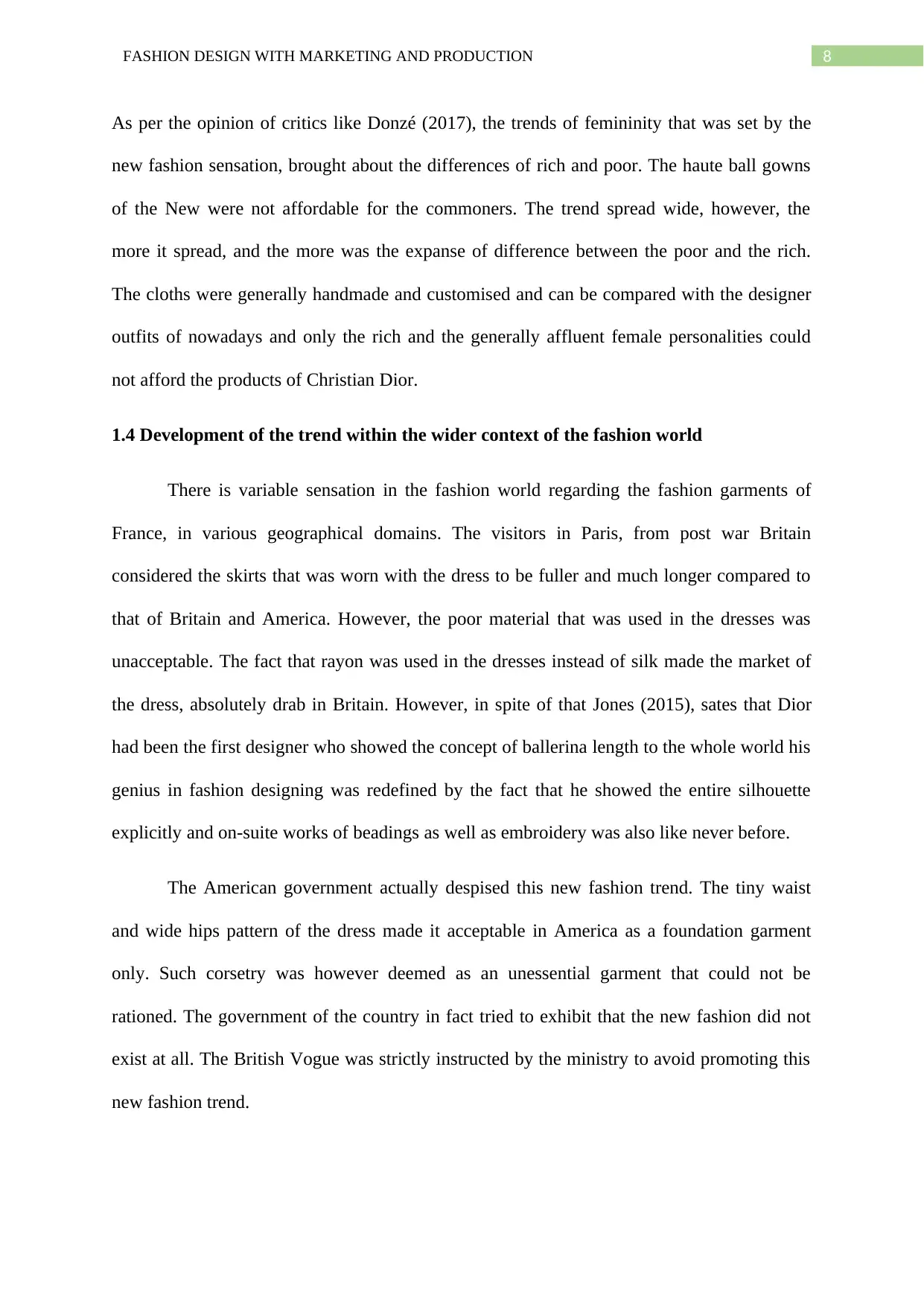
8FASHION DESIGN WITH MARKETING AND PRODUCTION
As per the opinion of critics like Donzé (2017), the trends of femininity that was set by the
new fashion sensation, brought about the differences of rich and poor. The haute ball gowns
of the New were not affordable for the commoners. The trend spread wide, however, the
more it spread, and the more was the expanse of difference between the poor and the rich.
The cloths were generally handmade and customised and can be compared with the designer
outfits of nowadays and only the rich and the generally affluent female personalities could
not afford the products of Christian Dior.
1.4 Development of the trend within the wider context of the fashion world
There is variable sensation in the fashion world regarding the fashion garments of
France, in various geographical domains. The visitors in Paris, from post war Britain
considered the skirts that was worn with the dress to be fuller and much longer compared to
that of Britain and America. However, the poor material that was used in the dresses was
unacceptable. The fact that rayon was used in the dresses instead of silk made the market of
the dress, absolutely drab in Britain. However, in spite of that Jones (2015), sates that Dior
had been the first designer who showed the concept of ballerina length to the whole world his
genius in fashion designing was redefined by the fact that he showed the entire silhouette
explicitly and on-suite works of beadings as well as embroidery was also like never before.
The American government actually despised this new fashion trend. The tiny waist
and wide hips pattern of the dress made it acceptable in America as a foundation garment
only. Such corsetry was however deemed as an unessential garment that could not be
rationed. The government of the country in fact tried to exhibit that the new fashion did not
exist at all. The British Vogue was strictly instructed by the ministry to avoid promoting this
new fashion trend.
As per the opinion of critics like Donzé (2017), the trends of femininity that was set by the
new fashion sensation, brought about the differences of rich and poor. The haute ball gowns
of the New were not affordable for the commoners. The trend spread wide, however, the
more it spread, and the more was the expanse of difference between the poor and the rich.
The cloths were generally handmade and customised and can be compared with the designer
outfits of nowadays and only the rich and the generally affluent female personalities could
not afford the products of Christian Dior.
1.4 Development of the trend within the wider context of the fashion world
There is variable sensation in the fashion world regarding the fashion garments of
France, in various geographical domains. The visitors in Paris, from post war Britain
considered the skirts that was worn with the dress to be fuller and much longer compared to
that of Britain and America. However, the poor material that was used in the dresses was
unacceptable. The fact that rayon was used in the dresses instead of silk made the market of
the dress, absolutely drab in Britain. However, in spite of that Jones (2015), sates that Dior
had been the first designer who showed the concept of ballerina length to the whole world his
genius in fashion designing was redefined by the fact that he showed the entire silhouette
explicitly and on-suite works of beadings as well as embroidery was also like never before.
The American government actually despised this new fashion trend. The tiny waist
and wide hips pattern of the dress made it acceptable in America as a foundation garment
only. Such corsetry was however deemed as an unessential garment that could not be
rationed. The government of the country in fact tried to exhibit that the new fashion did not
exist at all. The British Vogue was strictly instructed by the ministry to avoid promoting this
new fashion trend.
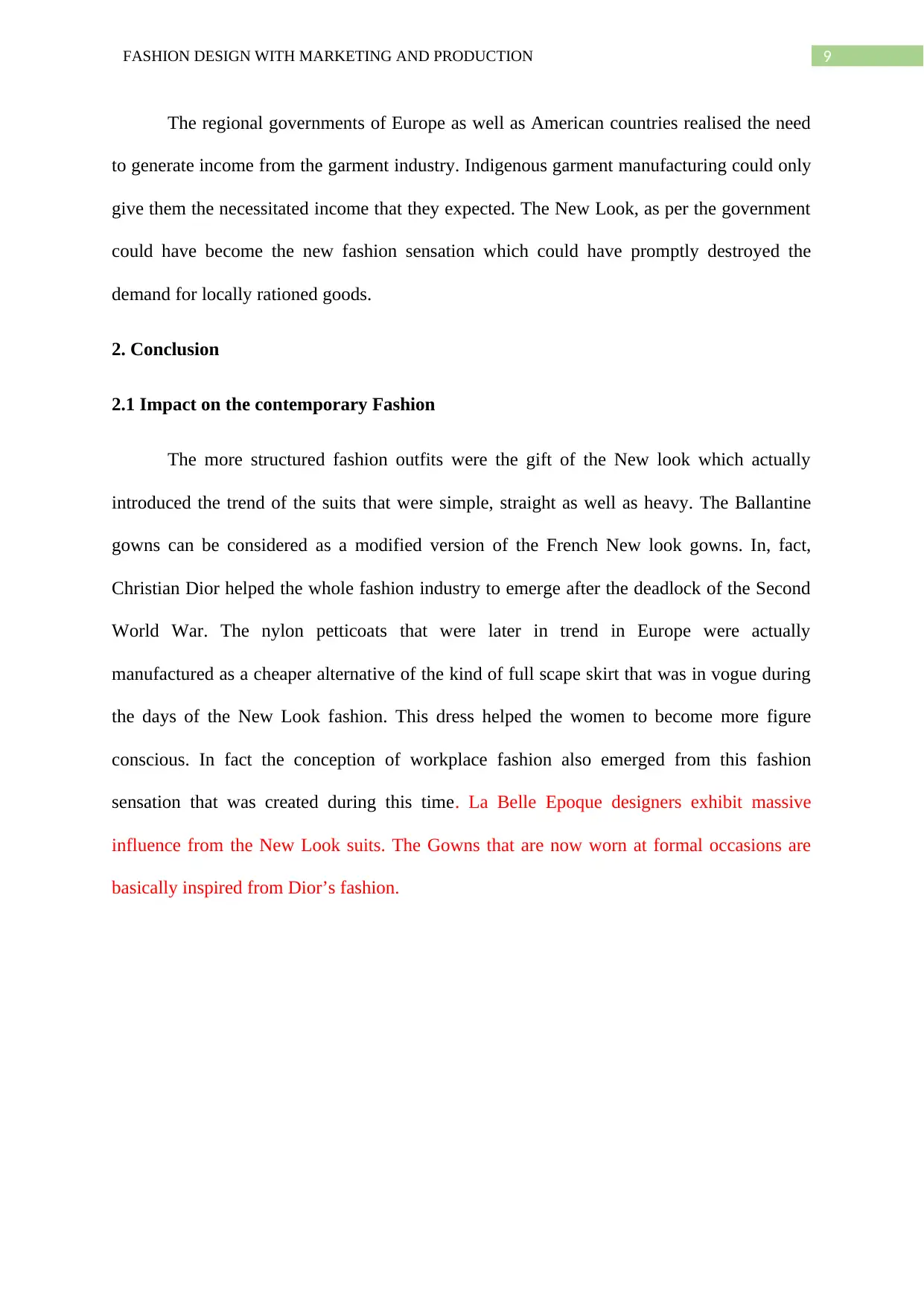
9FASHION DESIGN WITH MARKETING AND PRODUCTION
The regional governments of Europe as well as American countries realised the need
to generate income from the garment industry. Indigenous garment manufacturing could only
give them the necessitated income that they expected. The New Look, as per the government
could have become the new fashion sensation which could have promptly destroyed the
demand for locally rationed goods.
2. Conclusion
2.1 Impact on the contemporary Fashion
The more structured fashion outfits were the gift of the New look which actually
introduced the trend of the suits that were simple, straight as well as heavy. The Ballantine
gowns can be considered as a modified version of the French New look gowns. In, fact,
Christian Dior helped the whole fashion industry to emerge after the deadlock of the Second
World War. The nylon petticoats that were later in trend in Europe were actually
manufactured as a cheaper alternative of the kind of full scape skirt that was in vogue during
the days of the New Look fashion. This dress helped the women to become more figure
conscious. In fact the conception of workplace fashion also emerged from this fashion
sensation that was created during this time. La Belle Epoque designers exhibit massive
influence from the New Look suits. The Gowns that are now worn at formal occasions are
basically inspired from Dior’s fashion.
The regional governments of Europe as well as American countries realised the need
to generate income from the garment industry. Indigenous garment manufacturing could only
give them the necessitated income that they expected. The New Look, as per the government
could have become the new fashion sensation which could have promptly destroyed the
demand for locally rationed goods.
2. Conclusion
2.1 Impact on the contemporary Fashion
The more structured fashion outfits were the gift of the New look which actually
introduced the trend of the suits that were simple, straight as well as heavy. The Ballantine
gowns can be considered as a modified version of the French New look gowns. In, fact,
Christian Dior helped the whole fashion industry to emerge after the deadlock of the Second
World War. The nylon petticoats that were later in trend in Europe were actually
manufactured as a cheaper alternative of the kind of full scape skirt that was in vogue during
the days of the New Look fashion. This dress helped the women to become more figure
conscious. In fact the conception of workplace fashion also emerged from this fashion
sensation that was created during this time. La Belle Epoque designers exhibit massive
influence from the New Look suits. The Gowns that are now worn at formal occasions are
basically inspired from Dior’s fashion.
⊘ This is a preview!⊘
Do you want full access?
Subscribe today to unlock all pages.

Trusted by 1+ million students worldwide

10FASHION DESIGN WITH MARKETING AND PRODUCTION
Reference List
Arnold, R., 2018. Dior: Couturier du rêve: Musée des Arts Decoratifs, Paris July 5, 2017–
January 7, 2018. West 86th: A Journal of Decorative Arts, Design History, and Material
Culture, 25(1), pp.115-117.
Kessler, E.A., 2015. Cutting through abundance: Raf Simons and the artful slice. journal of
visual culture, 14(2), pp.208-212.
Lagier, J. and Ranfagni, S., 2018, July. LUXURY BRAND IDENTITY AND HERITAGE
IN TRANSITION IN LUXURY CAPITALS: THE CASE OF CHRISTIAN DIOR. In 2018
Global Marketing Conference at Tokyo (pp. 1512-1516).
Izberk-Bilgin, E. and Nakata, C.C., 2016. A new look at faith-based marketing: The global
halal market. Business horizons, 59(3), pp.285-292.
Reis, B.M., Miguel, R., Jerónimo, N.A., Pereira, M. and Azevedo, S., 2018, October.
Analysis of attributes in unisex and genderless clothing. In Reverse Design: A Current
Scientific Vision From the International Fashion and Design Congress (p. 87). CRC Press.
Parmentier, M.A., 2016. High heels. Consumption Markets & Culture, 19(6), pp.511-519.
Jones, K.B., 2015. ‘when one dior closes…’: the discourse of designer changeovers at
historic fashion houses. Fashion, Style & Popular Culture, 2(3), pp.321-331.
Reference List
Arnold, R., 2018. Dior: Couturier du rêve: Musée des Arts Decoratifs, Paris July 5, 2017–
January 7, 2018. West 86th: A Journal of Decorative Arts, Design History, and Material
Culture, 25(1), pp.115-117.
Kessler, E.A., 2015. Cutting through abundance: Raf Simons and the artful slice. journal of
visual culture, 14(2), pp.208-212.
Lagier, J. and Ranfagni, S., 2018, July. LUXURY BRAND IDENTITY AND HERITAGE
IN TRANSITION IN LUXURY CAPITALS: THE CASE OF CHRISTIAN DIOR. In 2018
Global Marketing Conference at Tokyo (pp. 1512-1516).
Izberk-Bilgin, E. and Nakata, C.C., 2016. A new look at faith-based marketing: The global
halal market. Business horizons, 59(3), pp.285-292.
Reis, B.M., Miguel, R., Jerónimo, N.A., Pereira, M. and Azevedo, S., 2018, October.
Analysis of attributes in unisex and genderless clothing. In Reverse Design: A Current
Scientific Vision From the International Fashion and Design Congress (p. 87). CRC Press.
Parmentier, M.A., 2016. High heels. Consumption Markets & Culture, 19(6), pp.511-519.
Jones, K.B., 2015. ‘when one dior closes…’: the discourse of designer changeovers at
historic fashion houses. Fashion, Style & Popular Culture, 2(3), pp.321-331.
Paraphrase This Document
Need a fresh take? Get an instant paraphrase of this document with our AI Paraphraser
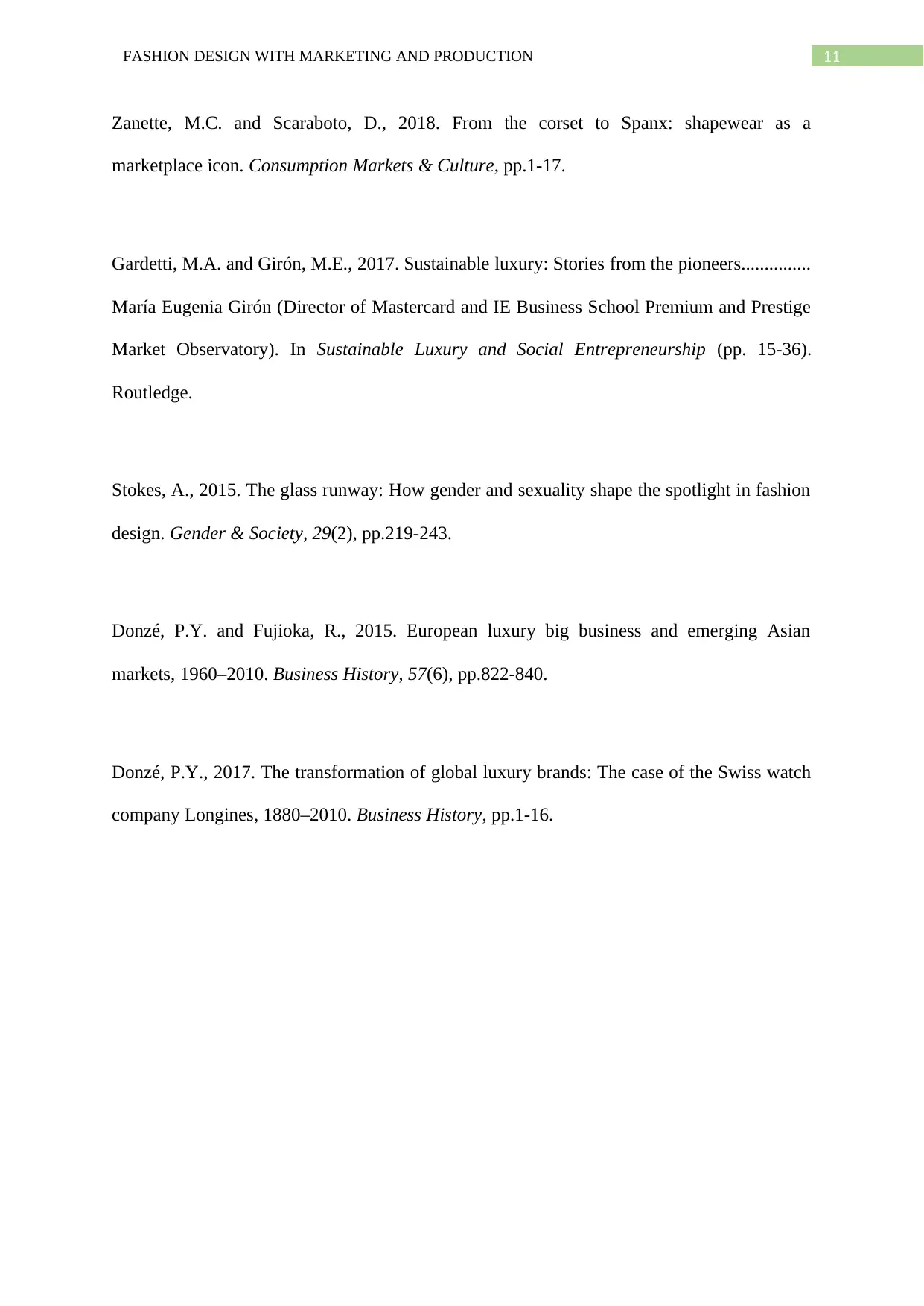
11FASHION DESIGN WITH MARKETING AND PRODUCTION
Zanette, M.C. and Scaraboto, D., 2018. From the corset to Spanx: shapewear as a
marketplace icon. Consumption Markets & Culture, pp.1-17.
Gardetti, M.A. and Girón, M.E., 2017. Sustainable luxury: Stories from the pioneers...............
María Eugenia Girón (Director of Mastercard and IE Business School Premium and Prestige
Market Observatory). In Sustainable Luxury and Social Entrepreneurship (pp. 15-36).
Routledge.
Stokes, A., 2015. The glass runway: How gender and sexuality shape the spotlight in fashion
design. Gender & Society, 29(2), pp.219-243.
Donzé, P.Y. and Fujioka, R., 2015. European luxury big business and emerging Asian
markets, 1960–2010. Business History, 57(6), pp.822-840.
Donzé, P.Y., 2017. The transformation of global luxury brands: The case of the Swiss watch
company Longines, 1880–2010. Business History, pp.1-16.
Zanette, M.C. and Scaraboto, D., 2018. From the corset to Spanx: shapewear as a
marketplace icon. Consumption Markets & Culture, pp.1-17.
Gardetti, M.A. and Girón, M.E., 2017. Sustainable luxury: Stories from the pioneers...............
María Eugenia Girón (Director of Mastercard and IE Business School Premium and Prestige
Market Observatory). In Sustainable Luxury and Social Entrepreneurship (pp. 15-36).
Routledge.
Stokes, A., 2015. The glass runway: How gender and sexuality shape the spotlight in fashion
design. Gender & Society, 29(2), pp.219-243.
Donzé, P.Y. and Fujioka, R., 2015. European luxury big business and emerging Asian
markets, 1960–2010. Business History, 57(6), pp.822-840.
Donzé, P.Y., 2017. The transformation of global luxury brands: The case of the Swiss watch
company Longines, 1880–2010. Business History, pp.1-16.
1 out of 11
Your All-in-One AI-Powered Toolkit for Academic Success.
+13062052269
info@desklib.com
Available 24*7 on WhatsApp / Email
![[object Object]](/_next/static/media/star-bottom.7253800d.svg)
Unlock your academic potential
Copyright © 2020–2025 A2Z Services. All Rights Reserved. Developed and managed by ZUCOL.
